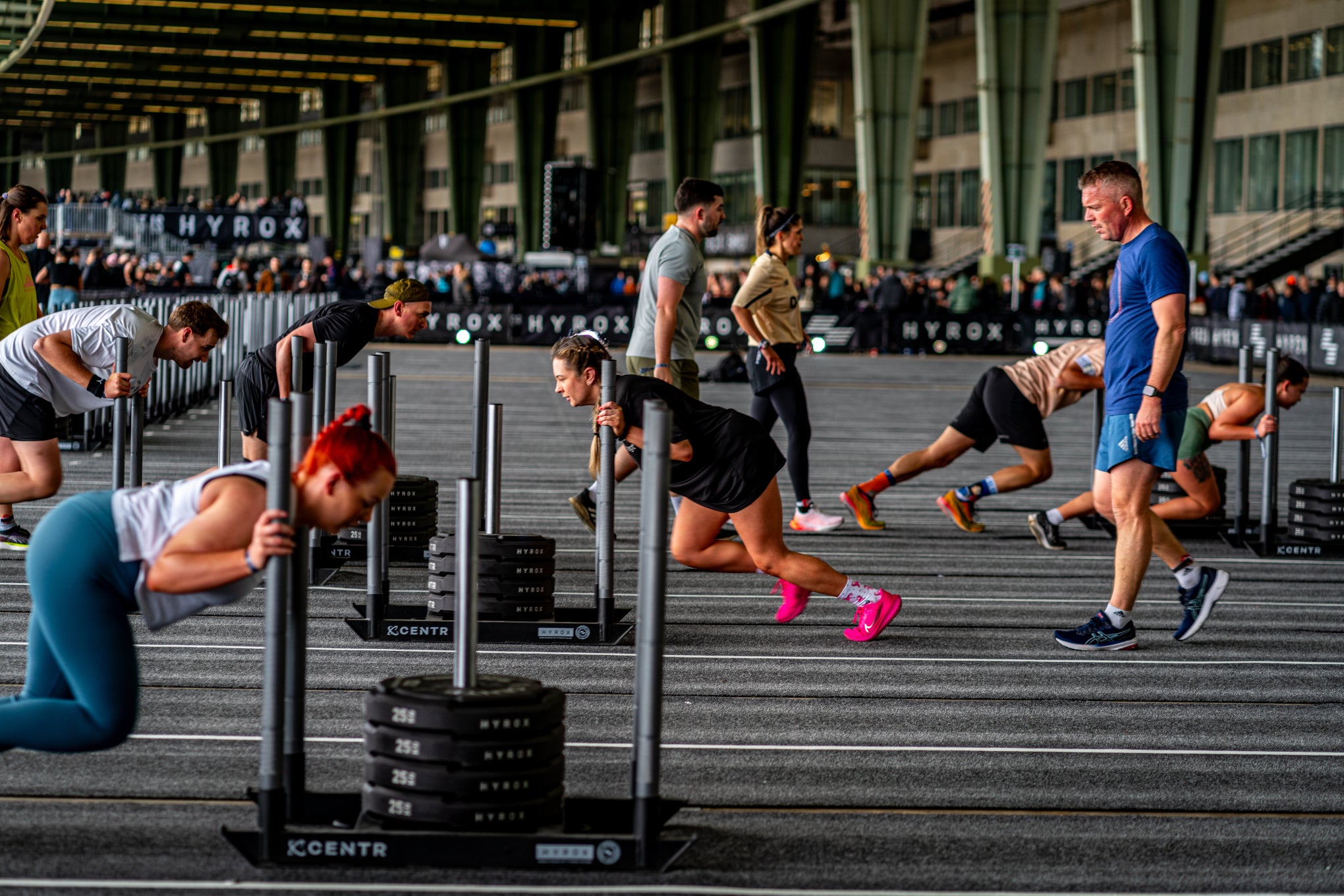
Deka, Hyrox, and the explosion of hybrid fitness racing
Hybrid fitness is big news, with events like Hyrox and Deka attracting big number around the world. These events combine functional fitness and strength with endurance. But what does it take to train for them (and should you do one?)
What is hybrid fitness?
“Hybrid” is a buzzword in fitness circles, and can mean any combination of different training modalities. But most people use the term hybrid to mean training, workouts, or events that combine cardio and strength. In the context of fitness racing, it typically involves a mix of:
- Cardio endurance (running, rowing, skiing)
- Strength training (weights or bodyweight exercises)
- Functional movements (sled pushes, loaded carries etc)
- Power and speed (sprints, plyometrics)
Why is hybrid fitness racing so popular?
Fitness trends tend to come around in circles, with each iteration building on previous versions. So it’s no surprise that the previous popularity of triathlon, Crossfit, OCR, and functional training has birthed this hybrid baby.
The combination of events in fitness racing is a good all-round challenge for participants, testing CV endurance, strength, power, and mental elements like strategy, team work, and toughness.
5 reasons fitness racing is so popular right now
Variety - hybrid races offer a diverse range of challenges making them exciting to train for and accomplish
Insta-worthy – these races are great for content, usually contained in a small area with a visually appealing aesthetic background.
Community – fitness races encourage a strong sense of community and camaraderie.
Functional fitness - the exercises choices in these events often mimic real-life movements (more than some other fitness competitions, anyway), making training feel more applicable to daily life.
Accessible – obviously you need a decent level of fitness and strength to do these races, but they all have levels suitable for beginners and teams not just elites.
How did the fitness racing trend start?
The hybrid fitness racing trend has its roots in OCR (obstacle course races) and functional fitness competitions. In the 80s and 90s, obstacle course races like Tough Mudder and Spartan Race started to gain traction. Then Crossfit entered the chat in the early 2000s and popularised the idea of competitive functional fitness. The CrossFit Games started in 2007, showcasing diverse fitness challenges that combined strength and cardio elements. In the 2010s, OCR became a recognised sport with standardised races and championships.
There are broader fitness trends that set the stage for the current popularity of hybrid fitness races. For example, during Covid lockdown lots of us got into running. And strength training has been a dominant trend for the last few years, especially amongst women.
History of Hyrox and Deka
Hyrox and Deka are currently the two dominant fitness racing brands. Hyrox is known for its standardised format that can be completed as an individual or a team of two: 8 x 1km runs followed by a workout station, each station being a different challenge.
Hyrox was founded in Germany in 2017 and the first Hyrox event was held in Hamburg that year.
As of 2023, Hyrox hosts over 60 events a year and had over 175,000 participants in the 2022-2023 season. The 2023 World Championships, held in Manchester, attracted over 3,000 athletes from 50 countries.
Deka was launched in 2019 by the guy who founded Spartan Race and – as the name suggests – has 10 fitness zones in a race. Deka offers three types of event: Deka Mile (10 fitness zones with a 160m run between each), Deka Strong (10 fitness zones, no running), and Deka Fit (and indoor version with shorter running distances.
As of 2023, Deka has more than 50 events across 15 countries, with the Deka Strong format accounting for about 40% of its total 75,000 participants. The average Deka event attracts 500-1,500 participants, with races in big cities drawing up to 3,000 competitors.
How fit do you need to be to do hybrid fitness races?
Events like Deka and Hyrox might look intense, but part of their appeal is their accessibility. Many offer scaled options, and the standard formats are achievable if you’ve got a decent baseline. If you can run 5km in intervals, and do functional movements (like squats, loaded carries, sled pulls), you can get through a fitness race.
How to train for your first hybrid fitness race
- Build a strong aerobic base - incorporate regular running, rowing, or cycling sessions and focus on steady-state and intervals.
- Strength train - include compound movements and build strength and muscular endurance.
- Functional fitness - practice race-specific movements (likely to include sled push or pull, loaded carries, burpee broad jumps, wall balls) and incorporate circuit training to improve work capacity.
- Specificity – mimic race conditions in your training (running followed by strength work) and practice transitions.
- Recovery – don’t neglect mobility, recovery, and nutrition as you juggle the demands of training for a hybrid event.
- Mental prep – work on strategies to deal with discomfort, high HR zones, nerves and stress, practice pacing and race day strategies, and talk to your partner if you’re doing a team event.
Hybrid fitness racing could be your next challenge. Let us know if you’re training for something like Hyrox or Deka?






